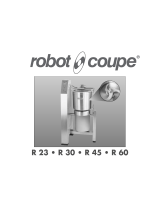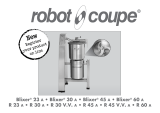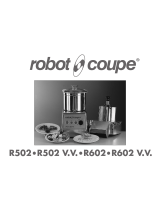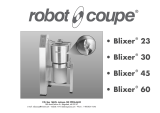Page is loading ...

Contents
Introduction 1
Installation 1-
Use, safety 3
Cleaning and hygiene 4
Fault fi nding 5
Maintenance 5
Conformity with regulations 6
Introduction
1.1 DESCRIPTION
• This cutter is a machine designed for cookery professionals
for mincing, mixing, emulsifying, liquidising, kneading, etc, and
can be used to process all types of foodstuffs (meat, vegetables,
fruits, condiments, pastry, mayonnaise, etc.).
• For special preparations other than foodstuffs: (PLEASE ASK
US FOR DETAILS)
1.1
A Feet
B Casing
C Body
D STOP - START buttons
Continual pressure
E Drive shaft
F Bowl (2.5 litre capacity)
G Rotor
H Cover
2.1 DIMENSIONS - WEIGHT (FOR INFORMATION ONLY)
- Dimensions of packaging : 340 x 260 x 420 mm
- Net weight : 297 x 216 x 371 mm
- Gross weight when packaged
: 13.4 Kg
- Net weight : 12.4 Kg
2.1
2.2 LOCATION
• The cutter is designed to be fi tted onto a work top (table, base,
etc.) of between 700 and 900 mm maximum in height. Its four
feet ensure that it remains perfectly stable.
• The cutter does not need to be fi xed in place and may be
moved easily.
Installation
06/2007
GB
This document is to be used in conjunction with the original manufacturer's manual.
The symbols correspond with the numbered drawings of the original manual.
Introduction
The User Manual contains useful information for the user on
how to work correctly and in complete safety, and is designed
to make it easier to use the machine (called «machine» or
«appliance» below).
What follows is in no case intended to be a long list of warnings
and constraints, but rather a series of instructions meant to
improve the service provided by the machine in every respect,
and particularly to avoid a series of injuries or damage to equi-
pment that might result from inappropriate procedures for use
and management.
It is essential that all the people responsible for transporting,
installing, commissioning, using, maintaining, repairing or dismant-
ling the machine should consult this manual and read it carefully
before proceeding with the various operations, in order to avoid
any incorrect or inappropriate handling that might be result in
damage to the machine or put people’s safety at risk.
It is just as important that the Manual should always be available
to the operator and it should be kept carefully where the machine
is used ready for easy and immediate consultation in case of any
doubt, or in any case, whenever the need arises.
If after reading the Manual, there are still any doubts concerning
how to use the machine, please do not hesitate to contact the
Manufacturer or approved After Sales Service provider, who
is constantly available to ensure quick and careful service for
improved machine operation and optimum effi ciency.
Note that the safety, hygiene and environmental protection stan-
dards currently applicable in the country where the machine is
installed must always be applied during all phases of machine
operation. Consequently it is the user’s responsibility to ensure
that the machine is operated and used solely under the optimum
safety conditions laid down for people, animals and property.
1
K 25 GB 06 07

• The machine uses a single phase power supply with a
mould-
ed 2 pin + earth plug.
• Check that the voltage of the electrical system is the same as
that marked on the rating plate and the power cable.
• The machine must be protected by a differential circuit break-er
and a 16 A fuse.
2.3
The machine must be earthed
Connection to the electrical power supply must be done according to proper professional practice by a qualifi ed and authorised
person (see current standards and legislation in the country of installation).
If an adapter is used on the socket, a check must be made that the electrical characteristics of this adapter are not lower than
those of the machine.
Do not use multiple plugs
The AC power supply to the machine must comply with the following conditions;
- Maximum voltage variation: ±5%
- Maximum frequency variation: ±1% on a continuous basis, ± 2% over short periods
ATTENTION: the electrical installation must comply (for design, creation and maintenance) with the legal and standard
requirements in the country where used.
- Before connecting the machine to the electrical power supply, check that the voltage of the electrical system is the same as
that marked on the rating plate and the label on the power cable.
- The machine’s electrical power supply must be protected against voltage surges (short-circuits and excess voltages) by
using fuses or thermal relays of the appropriate gauge relative to the place of installation and machine specifi cations - see the
specifi cations shown in column G of fi gure 2.3a
ATTENTION: Concerning protection against indirect contact (depending on the type of power supply provided and
connection of the exposed conductive parts to the equipotential protection circuit), refer to point 6.3.3 of EN 60204-1 (IEC
60204-1) with the use of protection devices for automatic shut-off of power in the event of an insulation fault with a TN or
TT system, or, for the IT system, with the use of a permanent insulation or differentials controller for automatic shut-off.
The requirements of IEC 60364-4-41, 413.1 must apply for this protection.
For example: in a TT system, a differential circuit breaker must be installed upline of the power supply, with a suitable
power cut-off (e.g.: 30 mA) on the earthing installation for the place where it is planned to install the machine.
ATTENTION: Failure to comply with these instructions means the customer runs the risk of machine failure and/or acci-
dents due to direct or indirect contacts.
ATTENTION !!
2.3 ELECTRICAL CONNECTION
• Motor characteristics:
B Number of phases (1 single phase)
C Nominal voltage in volts (value, range or commutation)
D Frequency (Hertz)
E Nominal power (Watts)
F Nominal current (Amperes)
G Approximate electrical consumption (kWh)
To PAT test the Electrolux Range of Food Preparation Equipment,
the PCB board needs to be disconnected before any test is done.
This is due to the fact that the boards are fi tted with a grounding
diode that can give incorrect result during such a test. Also on
a standard appliance a fl ash test of 25 amps and up to 3000v is
used but, as you would expect, to use this on equipment, which
has a printed circuit, board would be quite destructive to that
board. We would recommend the use of a PAT tester approved
for computer systems which use a lower rate of amps.
The appliance is perfectly safe and is CE certifi cated. There are
two ways to get overcome this problem.
· Disconnect the board as instructed and test using test for
PC’s,
· Or install the mixer on a fused spur (no plug) as this takes it
away from being a portable appliance and the PAT test is then
not needed.
K 25 GB 06 07
2

Use, Safety
Machine storage: -25°C to +50°C
Ambient temperature during operation: +4°C to +40°C
Clean the machine properly prior to its fi rst use
This machine is for professional use and must be used by staff trained to use, clean and maintain it, in terms or reliability and
safety.
Use the machine in adequately lit premises (See applicable technical standard for the country of use. In Europe, refer to standard
EN 12464-1)
When handling the machine, always check that the parts taken hold of are not mobile elements: risk of dropping and injury to
the lower limbs.
Uncontrolled closure of the lid or ram press involves a risk of crushing the fi ngers.
Never put a hand in the ejection area while the machine is in operation; risk of injury. It is strictly forbidden to put the safety
systems out of action or modify them: Risk of permanent injury!!!!
Check that the safety devices operate correctly each time before using (see paragraph on «safety system adjustments»).
Never put a hand, a hard or frozen object in the appliance
For health and safety reasons, always use a washable or disposable strong head covering that covers the hair completely.
ATTENTION: All operations, whether using, cleaning or maintenance, present risks of cuts; never force and always keep
hands a reasonable distance from cutting edges.
Always use appropriate protective equipment when carrying out these operations.
The machine is not designed for use in explosive atmospheres.
ATTENTION !!
3.1 USER SAFETY IS ENSURED BY:
- The braked stoppage of the motor when the cover is unlock-
ed before the rotor may be accessed.
- The motor not starting if the cutter cover is missing.
- The CONTINUOUS OPERATION or CONTINUAL PRESSURE
buttons needing to be pressed before the machine will start
("no volt" release).
- OPERATION using continual pressure to control the develop-
ment of the products being processed.
- The automatic locking in place of the rotor when it rotates
linked to the angling of the blades (DITO SAMA patent).
- The standardised size of the cover spout which allows prod-
ucts to be added in MID-CYCLE and the design of the bowl
(leak resistant tube).
- The easy dismantling of the bowl, the cover and the rot or for
cleaning.
- Respecting the instructions of this manual for the use, clean
ing and maintenance of the machine.
RESIDUAL RISKS
The machine presents the following residual risks;
• If a hand is placed in the area where the products are dis-
charged, it may be crushed or trapped by the rotating parts of
the machine.
• Fascia
A STOP button
B START button by continual pressure
C START button for continuous operation
a) Continuous operation:
- Push the button C
b) Operation with continual pressure:
- Keep the button B pressed in, which allows delicate work to
be controlled.
c) Stoppage:
- Press the button A
Note:
- Avoid stopping the cutter by unlocking the cover.
- It is possible to switch from continuous OPERATION to OP-
ERATION by continual pressure without pressing the STOP
button.
3.1
• The cover on the body:
- Position it so that the pins fi t into the slots of the body, then
turn it anti-clockwise
as far as possible so that it locks into
place.
- Its external profi le should match up with that of the body.
• To dismantle it, carry out the operations in reverse order.
• The rotor may be removed when the bowl is fi lled with liquid.
3.2A
3.2 USE OF THE CUTTERS
Before fi tting the cutters, check the cleanliness of the centring
and slots of the body, the drive shaft, the rotor, the bowl and
the cover.
To equip the machine, fi t:
• The bowl onto the motor body, by positioning it so that the pins
fi t into the slots in the body, then interlock it.
• The rotor on the upper fl at of the drive shaft and check that it
is correctly seated (cutter approximately 2 mm below the bottom
of the bowl).
3.2B
3.2C
3
K 25 GB 06 07

3.
3 USE OF THE EQUIPMENT
• The cutter will only operate correctly if the cover is locked in
position properly onto the body, otherwise the safety device will
be triggered and the machine will not start.
- Fit the bowl and the rotor (see § 3.2) then load the products
to be processed into the bowl and close the cover..
- Press the START or CONTINUAL PRESSURE button.
Note: Liquids or ingredients may be introduced via the hole in the
centre of the cover in mid-cycle.
- The height of the central tube of the bowl and the rotor en-
sure a perfect seal for liquids.
- The angle of the blades guarantees a rapid and consistent
mixture.
Never introduce your hand or a hard object into the bowl
when the machine is in operation.
Always install the rotor after positioning the bowl
3.4 SOME POSSIBLE APPLICATIONS
The quantities are given for information purposes only.
PRODUCTS
MEATS
ROUGH MINCING
- Terrines
- Sausages
- Beef burgers
Fine mincing
- Stuffi ng
- Mousses
- Min./max. quantities
FRUITS AND VEGETABLES
- Purées
- Mousses
- Stewed fruits
- Coulis
- Min./max. quantities
CHOPPING
- Parsley
- Onion
- Max. quantities
POWDER
- Almonds
- Hazelnuts
PRODUCTS
PASTRY
- Shortcrust
- Shortbread
- Cold water paste
- Puff
- Quiche
- Min. / Max. quantities
VARIOUS
- Mayonnaise
- Min. / Max. quantities
- Butter sauce for snails
- Min./ Max. quantities
REMARKS
Place all of the ingredients in the bowl: fl our,
salt, butter and water.It only takes a few se-
conds to prepare the pastry (10 - 15 s). The
water used must be cold in order to prevent
the pastry from becoming too hot.
For cold water paste, with the maximum
quantity, the water must be added to the
fl our and mixed immediately.
100 gr. / 800 gr. of fl our
The bowl and the ingredients must be at
room temperature (if necessary, warm
the bowl).
Mix the eggs, mustard, salt and pepper by
pressing the continual pressure button, then
carefully add the oil.
As soon as the mayonnaise thickens, add
the oil more rapidly.
For small quantities, cover the bottom of
the bowl with oil and increase the quantity
of mustard.
1 egg / 1 litre of oil.
Chop the parsley, garlic, shallots and then
add the butter(avoid using cold butter). Use
either continuous operation or continual
pressure to mix it all together.
1 kg of butter.
REMARKS
All types of stuffi ng and mousses
Short duration (10 to 30 seconds),
depending upon the thickness desired.
Longer duration (1 to 4 minutes)
Check that the blades are kept sharp.
100 gr / 800 gr
Same recommendations for the sharpness
and the suitability depending on the quantity
of product processed.
100 gr / 1 kg
Use very sharp blades.
The parsley must be dried thoroughly.
Fill the bowl
Use different cycle times to obtain the de-
sired smoothness.
Cleaning and hygiene
ATTENTION !!
Before dismantling any part, disconnect the appliance from the power supply.
Before using any cleaning product, be sure to read the instruction and safety instructions accompanying the product and use
appropriate protective equipment.
Do not clean the machine with a pressure cleaner
4.1 IN BETWEEN USE
• Remove the bowl, cover and the rotor (see § 3.2).
• Using running water or a bowl of water to clean these parts,
using hot water as well as a detergent - degreaser - disinfectant
(if working with greasy products).
• Check that the parts have been cleaned properly.
Note:
- Use cleaning products that are compatible with the plastic
(polycarbonate) and stainless steel parts.
- Do not use abrasive products to clean the transparent cover.
Handle the rotor carefully.
(risk of CUTS, IMPACTS, etc.).
K 25 GB 06 07
4

- In order to avoid acid stains on the rotor blades, we recommend
that they be dried thoroughly before putting them away, and
to keep the rotor in a cold place to limit the development of
germs
- After cleaning and drying the lid, the rotor and the bowl, replace
the assembly on the cutter.
• Periodically:
- Clean the dust from the ventilation holes underneath the machine.
4.2 AFTER USE
• Unplug the machine.
• To remove and clean the rotor, cover and bowl, see § 3.2 and 4.1.
• If necessary, clean the outside of the machine with a damp
sponge and a detergent - disinfectant, paying particular attention
to the rotor drive shaft and the bowl support, then rinse.
Note:
- Use cleaning products that are compatible with the materials
of the machine.
- The drive shaft and the inside of the rotor must be kept perfectly
clean.
- The bowl and the rotor may be cleaned in a dishwasher if the
blades are protected against impacts.
5.1 THE MACHINE WILL NOT START, CHECK THAT:
• The machine is plugged in.
• The electrical power supply to the socket is correct.
• The cover is closed (see § 3.2).
Fault fi nding
5.2 ABNORMAL NOISES
• Stop the machine.
• Check:
- that the rotor and bowl are fi tted correctly.
- that there are no foreign bodies inside the bowl.
• Remove, clean if necessary and refi t.
5.3 WORK QUALITY
• To obtain perfect and rapid results without overheating:
- always use sharp, undamaged blades,
- use another rotor for delicate work (e.g. chopping of parsley).
- avoid using excessive quantities of products, which may cause
overheating (meat, pastry).
If the problem persists,
contact the service department of your local dealer.
Note:
- if necessary, redress the edge of the blades on the opposite
side to where they have been sharpened, using the grind-stone
supplied with the machine.
Maintenance
ATTENTION !!
Before dismantling any part, disconnect the appliance from the power supply.
Maintenance may only be carried out by a qualifi ed, trained and authorised person
6.1 MECHANICAL PARTS
• The cutter requires a minimum amount of maintenance (the
motor and the mechanical part bearings are greased for life).
• It is recommended to perform the following operations at least
once a year:
- grease, with a grease that is suitable for use with food, the
seal at the bottom of the drive shaft
- the condition of the electrical connections.
• Access to electrical components:
- Unplug the machine.
- Remove the casing.
• The capacitors may retain an electrical charge. To avoid taking
any risks when carrying out work, we recommend discharging
them by connecting their terminals with an insulated conductor
(e.g. a screwdriver).
Residual voltage at the capacitor terminals.
6.2 ADJUSTMENT OF THE SAFETY DEVICES
• Check that the safety device is operating correctly on a regular
basis. The motor should stop within less than 4 seconds when
the lid is opened.
• If this does not work:
- do not use the machine
- have it adjusted by the service department of your local dealer.
5
K 25 GB 06 07

6.3 ELECTRICAL COMPONENTS
See electrical diagrams.
• Identifi cation of the colours of the wires:
- Power circuit : black
- Control circuit : red
- Motor : (G)
Orange- (F) black- (A) red- (E) blue-
(H)
Violet
- Phases : L Single phase
- Neutral : N
- Earth : V/J yellow and green
- Control cable : (J)
Brown- (I) grey - (K) pink- (E) blue -
(D) white
• Identifi cation of the components:
O : STOP button
I : START button
P : Continual pressure START button
S1 : Cover safety device
M1 : Single phase motor
CD/F : Start-up/braking condenser
CP : Permanent condenser
K : Klixon relay
CPu : Power board
6.3
6.4 ADDRESS FOR SERVICE REQUIREMENTS
We advise you to contact the dealer who sold you the ma-
chine.
• The manufacturer reserves the right to modify and make
improvements to the products without giving prior warning.
For any information or orders for spare parts, specify the type
of machine, its serial number and the electrical char-
acteristics.
Dealer's stamp
Date of purchase:..............................................
K 25 GB 06 07
6
The machine has been designed and manufactured in
conformity with:
- Machine directive 2006/42 EEC
- The CEM directive 2004/108EEC
- 2006/95/EEC: Low Voltage Directive
- 2002/95/EC: Equipment recycling directive
2002/96/CEE « WEEE »
The symbol « » on the product indicates that this product
may not be treated as household waste. Instead it shall be
handed over to the applicable collection point for the recycling
of electrical and electronic equipment. By ensuring this product
is disposed of correctly, you will help prevent potential negative
consequences for the environment and human health, which
could otherwise be caused by inappropriate waste handling
of this product. For more detailed information about recycling
of this product, please contact the sales agent or dealer for
your product, your after-sales service, or the appropriate waste
disposal service.
2006/12/CEE “Waste”
The machine is designed so that it does not contribute, or as
little as possible, to increasing the quantity or harmfulness of the
waste and the risks of pollution.
Make sure to observe the recycling conditions.
94/62/CEE “Packaging and packaging waste”
The packaging for the machine is designed so that it does not
contribute, or as little as possible to increasing the quantity or
harmfulness of the waste and the risks of pollution.
Make sure to eliminate the various parts of the packaging in
appropriate recycling centres.
- To the European standards:
EN 12852 - Culinary preparations. safety and hygiene
related presentations.
EN 60 204-1-2006 electrical equipment of machines,
This conformity is certifi ed by:
- The CE conformity mark, attached to the machine
- The corresponding CE declaration of conformity, associated
with the warranty.
- This instruction manual, which must be given to the operator.
Acoustic characteristics:
- The acoustic pressure level measured in conformity with the
EN ISO 3743.1-EN SIO 3744 < 70 dBA
Protection indices as per the EN 60529-2000 standard:
- IP55 electrical controls
- IP34 overall machine
Electromagnetic compatibility in compliance with the fol-
lowing standards:
- EN 55014-1: Emission.
- EN 55014-2: Immunity.
Integrated safety
- The machine has been designed and manufactured in com-
pliance with the relevant standards and regulations, mentioned
above.
- Before using the machine, the operator must be trained to use
the machine and informed of any possible residual risks .
Food hygiene:
The machine is made from materials that conform to the following
regulations and standards:
- Directive 1935/2005/CEE: Materials and objects in contact
with foodstuffs.
- Standard EN 601-2004: cast aluminium alloy objects in contact
with foodstuffs.
- Directive EN 1672-2 : Prescriptions relating to hygiene
The surfaces of the food area are smooth and easy to clean. Use
detergents that are approved for food hygiene and respect the
instructions for their use.
The machine has been CNERPAC approved for food hygiene as
well as being granted the Certifi cate of Sanitary Conformity by
the Sanitary Research and Engineering Department.
Conformity with regulations
/




